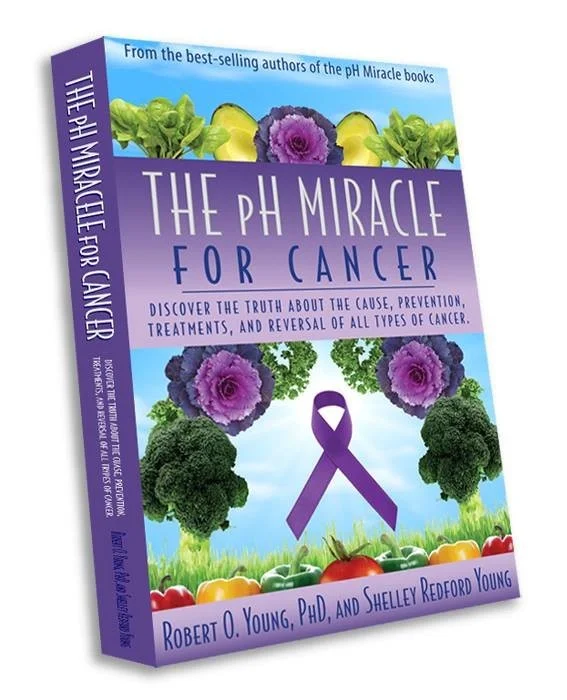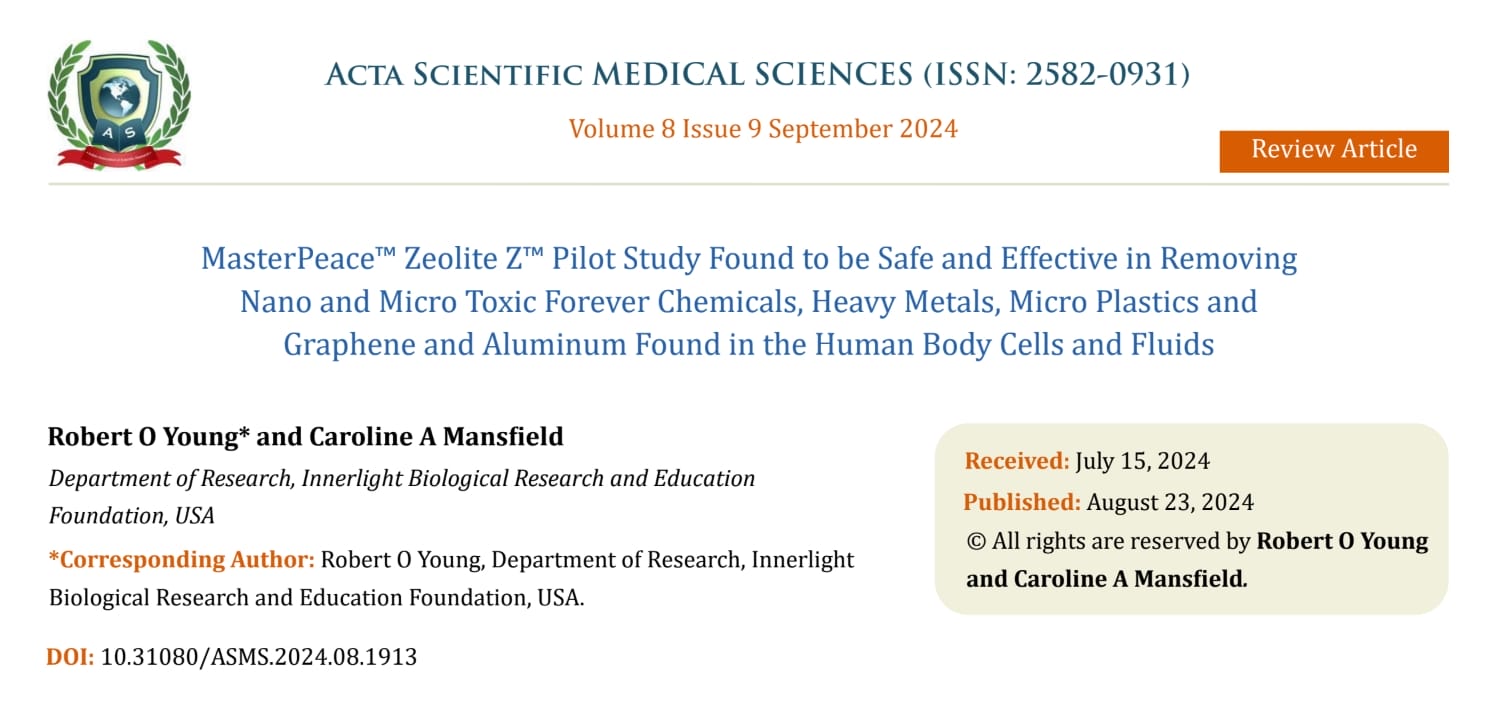A Natural Approach to Any Cancerous Condition?
Updated: Dec 13, 2020
Dr. Avril Campbell Danesh, an Oncologist and Cancer Research Scientist Testifies of the Efficacy of The pH Miracle for Cancer after 21 Days of Treatment!
Watch, listen and learn from Dr. Arvil Danesh a reputable oncologist and cancer research scientist who shares her experience following the pH Miracle for Cancer non-invasive cancer treatment protocol.
To learn more read The pH Miracle for Cancer and The pH Miracle revised and updated books. You can find these books online at: www.phmiracleproducts.com and www. and/or https://www.amazon.com/Robert-O.-Young/e/B001ILKCSU?ref_=dbs_p_ebk_r00_abau_000000

Learn more about the work, research, findings and publications of Dr. Robert O Young and Dr, Galina Migalko at the following links:
Dr. Robert O Young: www.drrobertyoung.com
Dr. Galina Migalko: www.universalmedicalimaging.com

Alkalizing Nutritional Therapy in the Prevention and Reversal of any Cancerous Condition
Robert O Young,1 Galina Migalko2
1 pH Miracle Center, USA 2 Medical doctor, non-invasive medical diagnostics, Universal Medical Imaging, USA
Correspondence: Robert O Young, pH Miracle Inc., 16390 Dia del Sol, Valley Center, California, 92082, USA, Tel 760 751 8321
Received: August 29, 2015 | Published: November 24, 2015
Citation: Young RO,Migalko G (2015) Alkalizing Nutritional Therapy in the Prevention and Reversal of any Cancerous Condition. Int J Complement Alt Med 2(1): 00046. DOI: 10.15406/ijcam.2015.02.00046
Abstract
Due to the evident ineffectiveness of conventional cancer treatments (e.g. chemotherapy and radiation), more efficient alternatives are needed. The potential of Alkaline Nutritional Infusion (ANI) as a legitimate alternative to chemotherapy and radiation is examined. While largely ignored in conventional oncology, the pH of the interstitial fluids is suggested as paramount in identifying a cancerous condition. It is further suggested that cancer is an over-acidic condition of the body that can be reversed and prevented with alkalizing treatments such as ANI. Full Body Bio-Electro Scan (FBBES) is presented as a noninvasive means to examine body pH and the presence of cancer. In addition, non-invasive Full-Body Thermography (FBT) and Full-Body Ultrasound (FBU) are presented as a noninvasive means to examine the physiology and the anatomy of the ograns, glands and tissues for inflammation, calcifications, cysts and tumors in the prevention and treatment of any cancerous condition. Finally, Live Blood Analysis (LBA) and Dried Blood Analysis (DBA) are non-invasive hematology tests for evaluating the health of the red and white blood cells and to view inflammatory and malignancy at the cellular level. In contrast to the acidosis caused by conventional cancer treatments, ANI methods such as Intravenous Nutritional Infusion (INI) and Rectal Nutritional Infusion (RNI) provide an alkalizing approach to cancer treatment and prevention.

To order this publication go to: https://www.phmiracleproducts.com/collections/books-audio-video/products/alkalizing-nutritional-therapy
Reversing Terminal Cancer – Pulmonary Adenocarcinoma Lung Cancer – From Terminal Cancer to Courage and a Self-Cure!
References
1. Adams KM, Lindel KC, Kohlmiier M, Zeisel SH (2006) Status of nutrition education in medical schools. Am J Clin Nutr 83(4): 941S-944S.
2. Bruer RA, Schmidt RE, Chapel T (1993) Nutrition education for physicians: alternative federal roles for creating an improved system. Macro International, Washington, USA.
3. Davis CH (1994) The report to Congress on the appropriate federal role in assuring access by medical students, residents, and practicing physicians to adequate training in nutrition. Public Health Rep 109(6): 824-826.
4. National Academy of Sciences (1985). Nutrition education in US medical schools. National Academy Press, Washington, DC, USA.
5. Feldman EB (1991) Educating physicians in nutrition-a view of the past, the present, and the future. Am J Clin Nutr 54(4): 618-622.
6. Darer JD, Hwang W, Pham HH, Bass EB, Anderson G (2004) More training needed in chronic care: a survey of US physicians. Acad Med 79(6): 541-548.
7. All schools reports (2004). Association of American Medical Colleges Medical School Graduation Questionnaire.
8. Torti F, Adams K, Edwards L, Lindell K, Zeisel S (2001) Survey of nutrition education in U.S. medical schools-an instructor based analysis. Med Educ Online 6: 8.
9. Association of American Medical Colleges Curriculum directory.
10. Weinsier RL, Boker JR, Brooks CM, Kushner RF, Visek WJ, et al. (1989) Priorities for nutrition content in a medical school curriculum: a national consensus of medical educators. Am J Clin Nutr 50(4): 707-712.
11. Mihalynuk TV, Scott CS, Coombs JB (2003) Self-reported nutrition proficiency is positively correlated with the perceived quality of nutrition training of family physicians in Washington State. Am J Clin Nutr 77(5): 1330-1336.
12. Kushner RF (1995) Barriers to providing nutrition counseling by physicians: a survey of primary care practitioners. Prev Med 24(6): 546-552.
13. Mihalynuk TV, Knopp RH, Scott CS, Coombs JB (2004) Physician informational needs in providing nutritional guidance to patients. Fam Med 36(10): 722-726.
14. Groos E, Walker L, Masters JR (1986) Intravesical chemotherapy. Studies on the relationship between pH and cytotoxicity. Cancer 58(6): 1199-1203.
15. Smith SR, Martin PA, Edwards RH (1991) Tumour pH and response to chemotherapy: an in vivo 31P magnetic resonance spectroscopy study in non-Hodgkin’s lymphoma. Br J Radiol 64(766): 923-928.
16. Raghunand N, Gillies RJ (2001) pH and chemotherapy. Novartis Found Symp 240: 199-211.
17. Raghunand N, He X, Van Sluis R, Mahoney B, Baggett B, et al. (1999) Enhancement of chemotherapy by manipulation of tumour pH. Br J Cancer 80(7): 1005-1011.
18. Sergei I, Grivennikov, Florian R, Greten, Michael K (2010) Immunity, Inflammation, and Cancer. Cell 140(6): 883-899
19. Joydeb KK, Young-Joon S (2008) Inflammation: Gearing the journey to cancer. Mutation Research 659: 15-30.
20. Researchers examine how BRD4 contributes to sustained presence of NF-kappa B in cancer cells.
21. Carmen B, Maria JP, Maria UL, Josefa C, Saioa G, et al. (2009) The Epidermal Growth Factor Receptor: A Link Between Inflammation and Liver Cancer. Exp Biol Med 234(7): 713-725.
22. Simone CB, Simone NL Simone V (2007) Antioxidants and other Nutrients Do Not Interfere With Chemotherapy or Radiation Therapy and Increase Kill and Survival. Altern Ther Health Med 13(2): 40-47.
23. Nick Barker, Johan H van Es, Jeroen Kuipers, Pekka Kujala, Maaike van den Born, et al. (2007) Identification of stem cells in small intestine and colon by marker gene Lgr5. Nature 449, 1003-1007 doi: 10.1038/nature06196.
24. Waugh A, Grant A (2007) Anatomy and Physiology in Health and Illness. 10th (edn), Churchill Livingstone, Philadelphia, Pa, USA.
25. Oceans reveal further impacts of climate change (2010). ScienceDaily, University of Alabama at Birmingham.
26. Hoegh-Guldberg O, Mumby PJ, Hooten AJ, Steneck RS, Greenfield P, et al. (2007) Coral reefs under rapid climate change and ocean acidification. Science 318(5857): 1737-1742.
27. Dam-ampai SO, Onthong J, Nilnond C (2005) Effect of cattle manure and dolomite on soil properties and plant growth in acid upland soils. Songklanakarin Journal of Science and Technologh 27(supplement 3): 727-737.
28. Ströhle A, Hahn A, Sebastian A (2010) Estimation of the dietdependent net acid load in 229 worldwide historically studied hunter-gatherer societies. Am J Clin Nutr 91(2): 406-412.
29. Sebastian A, Frassetto LA, Sellmeyer DE, Merriam RL, Morris RC Jr (2002) Estimation of the net acid load of the diet of ancestral preagricultural Homo sapiens and their hominid ancestors. Am J Clin Nutr 76(6): 1308-1316.
30. Frassetto L, Morris RC Jr, Sellmeyer DE, Todd K, Sebastian A (2001) Diet, evolution and aging-the pathophysiologic effects of the postagricultural inversion of the potassium-to-sodium and base-tochloride ratios in the human diet. European Journal of Nutrition 40(5): 200-213.
31. Konner M, Eaton SB (2010) Paleolithic nutrition: twenty-five years later. Nutr Clin Pract 25(6): 594-602.
32. Lindeman RD, Goldman R (1986) Anatomic and physiologic age changes in the kidney. Experimental Gerontology. 21(4-5): 379- 406.
33. Reddy ST, Wang CY, Sakhaee K, Brinkley L, Pak CY (2002) Effect of low-carbohydrate high-protein diets on acid-base balance, stoneforming propensity, and calcium metabolism. Am J Kidney Dis 40(2): 265-274.
34. Groos E, Walker L, Masters JR (1986) Intravesical chemotherapy. Studies on the relationship between pH and cytotoxicity. Cancer 58(6): 1199-1203.
35. Smith SR, Martin PA, Edwards RHT (1991) Tumour pH and response to chemotherapy: an in vivo 31P magnetic resonance spectroscopy study in non-Hodgkin’s lymphoma. Br J Radiol 64(766): 923-928.
36. Raghunand N, Gillies RJ (2001) pH and chemotherapy. Novartis Found Symp 240: 199-211.
37. Raghunand N, He X, Van Sluis R, Mahoney B, Baggett B, et al. (1999) Alkalizing Nutritional Therapy in the Prevention and Reversal of any Cancerous Condition 11/13 Copyright: ©2015 Young Citation: Young RO, Migalko G (2015) Alkalizing Nutritional Therapy in the Prevention and Reversal of any Cancerous Condition. Int J Complement Alt Med 2(1): 00046. DOI: 10.15406/ijcam.2015.02.00046 Enhancement of chemotherapy by manipulation of tumour pH. Br J Cancer 80(7): 1005-1011.
38. Louis Pasteur (1879) Studies on fermentation: The diseases of beer, their causes, and the means of preventing them. Macmillan Publishers, UK.
39. http://www.biodiversitylibrary.org/bibliography/32905#/ summary
40. Warburg O (1956) On the Origin of Cancer Cells. Science 123(3191): 309-314.
41. Wittig R, Coy JF (2008) The Role of Glucose Metabolism and Glucose-Associated Signaling in Cancer. Perspect Medicin Chem 1: 64-82.
42. Keith BA (1978) The Mechanism Involved and a High pH Therapy. Cancer Brewer Foundation, USA.
43. Kourtidis A, Ngok SP, Pulimeno P, Feathers RW, Carpio LR, et al. (2015) Distinct E-cadherin-based complexes regulate cell behaviour through miRNA processing or Src and p120 catenin activity. Nat Cell Biol 17(9): 1145-1157.
44. Nishikawa-Ogawa M, Wanibuchi H, Morimura K, Anna Kinoshita, Takayuki Nishikawa, et al. (2006) N-acetyl cysteine and S-methylcysteine inhibit MeIQx rat hepatocarcinogenesis in the post-initiation stage. Carcinogenesis. 27(5): 982-988.
45. Van Schooten FJ, Besaratinia A, De Flora S, D’Agostini F, Izzotti A, et al. (2002) Effects of oral administration of N-acetyl-L-cysteine: a multi-biomarker study in smokers. Cancer Epidemiol Biomarkers Prev 11(2):167-175.
46. Ponz de Leon M, Roncucci L (1997) Chemoprevention of colorectal tumors: role of lactulose and of other agents. Scand J Gastroenterol Suppl 222: 72-75.
47. Estensen RD, Levy M, Klopp SJ, Galbraith AR, Mandel JS, et al. (1999) N-acetyl cysteine suppression of the proliferative index in the colon of patients with previous adenomatous colonic polyps. Cancer Lett 147(1-2): 109-114.
48. Roxanne Nelson (2013) One Size Fits All Drug Dosing Give Suboptimal Results. Medscape.
49. Prigerson HG, Bao Y, Shah MA, Paulk ME, LeBlanc TW (2015) Chemotherapy Use, Performance Status, and Quality of Life at the End of Life. JAMA Oncol 1(6): 778-784.
50. Cancer Treatment & Survivorship, Facts & Figures, Estimated Numbers of Cancer Survivors by State as of January 1, 2014.
51. Odes HS, Hogan DL, Steinbach JH, Ballesteros MA, Koss MA (1992) Measurement of gastric bicarbonate secretion in the human stomach: different methods produce discordant results. Scand J Gastroenterol 27(10): 829-836.
52. AF Basile, Ahyl AC, Feldman LC, Williams JR, Mooney PM (2014) Effects of sodium ions on trapping and transport of electrons at the SiO/4H-SiC interface. J of Appl Phys 115, 034502.
53. Campling BG, Sarda IR, Baer KA, Pang SC, Baker HM, et al. (1995) Secretion of atrial natriuretic peptide and vasopressin by small cell lung cancer. Cancer 75(10): 2442-2451.
54. US Department of Agriculture: Report of the Dietary Guidelines Advisory Committee Report on the Dietary Guidelines for Americans, 2010: Sodium, Potassium, and Water.
55. Aronson PS, Giebisch G (2011) Effects of pH on potassium: new explanations for old observations. J Am Soc Nephrol 22: 1981.
56. Sterns RH, Cox M, Feig PU, Singer I (1981) Internal potassium balance and the control of the plasma potassium concentration. Medicine (Baltimore) 60: 339.
57. Adrogué HJ, Madias NE (1981) Changes in plasma potassium concentration during acute acid-base disturbances. Am J Med 71: 456.
58. Adrogué HJ, Madias NE (2004) PCO2 and [K+]p in metabolic acidosis: certainty for the first and uncertainty for the other. J Am Soc Nephrol 15: 1667.
59. Magner PO, Robinson L, Halperin RM (1988) The plasma potassium concentration in metabolic acidosis: a re-evaluation. Am J Kidney Dis 11: 220.
60. Wiederseiner JM, Muser J, Lutz T (2004) Acute metabolic acidosis: characterization and diagnosis of the disorder and the plasma potassium response. J Am Soc Nephrol 15: 1589.
61. Fulop M (1979) Serum potassium in lactic acidosis and ketoacidosis. N Engl J Med 300: 1087.
62. Graber M (1993) A model of the hyperkalemia produced by metabolic acidosis. Am J Kidney Dis 22: 436.
63. Adrogué HJ, Chap Z, Ishida T, Field JB (1985) Role of the endocrine pancreas in the kalemic response to acute metabolic acidosis in conscious dogs. J Clin Invest 75: 798.
64. Szylman P, Better OS, Chaimowitz C, Rosler A (1976) Role of hyperkalemia in the metabolic acidosis of isolated hypoaldosteronism. N Engl J Med 294: 361.
65. Altenberg GA, Aristimuño PC, Amorena CE, Taquini AC (1989) Amiloride prevents the metabolic acidosis of a KCl load in nephrectomized rats. Clin Sci (Lond) 76: 649.
66. Rose BD (2001) Post TW. Clinical Physiology of Acid-Base and Electrolyte Disorders, (5th edn), McGraw-Hill, New York. p. 347.
67. DuBose TD Jr, Good DW (1991) Effects of chronic hyperkalemia on renal production and proximal tubule transport of ammonium in rats. Am J Physiol 260: F680.
68. DuBose TD Jr, Good DW (1992) Chronic hyperkalemia impairs ammonium transport and accumulation in the inner medulla of the rat. J Clin Invest 90: 1443.
69. Good DW (1994) Ammonium transport by the thick ascending limb of Henle’s loop. Annu Rev Physiol 56:623.
70. Attmane-Elakeb A, Mount DB, Sibella V (1998) Stimulation by in vivo and in vitro metabolic acidosis of expression of rBSC-1, the Na+-K+(NH4+)-2Cl- cotransporter of the rat medullary thick ascending limb. J Biol Chem 273: 33681.
71. Bourgeois S, Meer LV, Wootla B (2010) NHE4 is critical for the renal handling of ammonia in rodents. J Clin Invest 120:1895.
72. Sabatini S, Kurtzman NA (1984) The maintenance of metabolic alkalosis: factors which decrease bicarbonate excretion. Kidney Int 25: 357.
73. COOKE RE, SEGAR WE, CHEEK DB (1952) The extrarenal correction of alkalosis associated with potassium deficiency. J Clin Invest 31: 798.
74. Carlisle EJ, Donnelly SM, Vasuvattakul S (1991) Glue-sniffing and distal renal tubular acidosis: sticking to the facts. J Am Soc Nephrol 1: 1019.
75. Marla Heller (2007) The DASH Diet Action Plan, Amidon Press. Alkalizing Nutritional Therapy in the Prevention and Reversal of any Cancerous Condition 12/13 Copyright: ©2015 Young Citation: Young RO, Migalko G (2015) Alkalizing Nutritional Therapy in the Prevention and Reversal of any Cancerous Condition. Int J Complement Alt Med 2(1): 00046. DOI: 10.15406/ijcam.2015.02.00046
76. Rethinking Cancer.
77. Calcium supplementation may attenuate the hyperproliferation and hyperplasia induced in the mouse colon by a Western-style diet.
78. Richter F, Newmark HL, Richter A, Leung D, Lipkin M (1995) Inhibition of Western-diet induced hyperproliferation and hyperplasia in mouse colon by two sources of calcium. Carcinogenesis 16(11): 2685-2689.
79. Substances : Calcium : CK(232) : AC(35)Diseases : Colon Cancer : CK(895) : AC(233), Western-Style Diet Induced Toxicity : CK(6) : AC(3)Pharmacological Actions : Antiproliferative : CK(1061) : AC(775)
80. Wark PA, Lau R, Norat T, Kampman E (2012) “Magnesium intake and colorectal tumor risk: a case-control study and meta-analysis. Am J Clin Nutr 96(3): 622-631.
81. Costello LC, Feng P, Milon B, Tan M, Franklin RB (2004) Role of zinc in the pathogenesis and treatment of prostate cancer: critical issues to resolve. Prostate Cancer and Prostatic Dis 7(2): 111-117.
82. Bjelakovic G, Nikolova D, Gluud LL, Simonetti RG, Gluud C (2012) Antioxidant supplements for prevention of mortality in healthy participants and patients with various diseases. Cochrane Database Syst Rev 3: CD007176.
83. Chalasani N, Younossi Z, Lavine JE, Diehl AM, Brunt EM, et al. (2012) The diagnosis and management of non-alcoholic fatty liver disease: Practice guideline by the American Association for the Study of Liver Diseases, American College of Gastroenterology, and the American Gastroenterological Association. Am J Gastroenterol 55(6): 2005-2023.
84. Caraballoso M, Sacristan M, Serra C, Bonfill X (2003) Drugs for preventing lung cancer in healthy people. Cochrane Database Syst Rev (2): CD002141.
85. Hanberry BS, Berger R, Zastre JA (2014) High-dose vitamin B1 reduces proliferation in cancer cell lines analogous to dichloroacetate. Cancer Chemother Pharmacol 73(3): 585-594.
86. Bareford LM, Avaritt BR, Ghandehari H, Nan A, Swaan PW (2013) Riboflavin-targeted polymer conjugates for breast tumor delivery. Pharm Res 30(7): 1799-1812.
87. Ainiwaer J, Tuerhong A, Hasim A, Chengsong D, Liwei Z, et al. (2013) Association of the plasma riboflavin levels and riboflavin transporter (C20orf54) gene statuses in Kazak esophageal squamous cell carcinoma patients. Mol Biol Rep 40(5): 3769-3775.
88. Bassett J K, Severi G, Hodge A M, Baglietto L, Hopper JL, et al. (2013) Dietary intake of B vitamins and methionine and colorectal cancer risk. Nutr Cancer 65(5): 659-667.
89. Powers HJ (2003) Riboflavin (vitamin B-2) and health. Am J Clin Nutr 77(6): 1352-1360.
90. Chaves Neto AH, Pelizzaro-Rocha KJ, Fernandes MN, FerreiraHalder CV (2014) Antitumor activity of irradiated riboflavin on human renal carcinoma cell line 786-O. Tumour Biol 36(2): 595- 604.
91. Powers HJ (2005) Interaction among folate riboflavin genotype and cancer with reference to colorectal and cervical cancer. J Nutr 135(12 suppl): 2960S-2966S.
92. Kirkland JB (2003) Niacin and carcinogenesis. 46(2): 110-118.
93. Zhang SM, Moore SC, Lin J, Cook NR, Manson JE, et al. (2006) Folate vitamin B6 multivitamin supplements and colorectal cancer risk in women. Am J Epidemiol 163(2): 108-115.
94. Ma E, Iwasaki M, Kobayashi M, Kasuga Y, Yokoyama S, et al. (2009) Dietary intake of folate vitamin B2 vitamin B6 vitamin B12 genetic polymorphism of related enzymes and risk of breast cancer: a casecontrol study in Japan. Nutr Cancer 61(4): 447-456.
95. Kirkland JB (2003) Niacin and carcinogenesis. 46(2): 110-118.
96. Cameron E, Pauling L (1976) Supplemental ascorbate in the supportive treatment of cancer: Prolongation of survival times in terminal human cancer. Proc Natl Acad Sci U S A 73(10): 3685- 3689.
97. Cabanillas F (2010) Vitamin C and cancer: what can we conclude–1,609 patients and 33 years later?. Puerto Rico health sciences journal 29 (3): 215-217.
98. Grant WB (2012) Ecological studies of the UVB-vitamin D-cancer hypothesis. Anticancer Res 32(1): 223-236. , Substances : Vitamin D : CK(1682) : AC(238)Diseases : Bladder Cancer : CK(186) : AC(60), Breast Cancer : CK(2372) : AC(660), Cervical Cancer : CK(378) : AC(69), Colon Cancer : CK(895) : AC(233), Colorectal Cancer : CK(877) : AC(321),Endometrial Cancer : CK(269) : AC(45), Esophageal Cancer : CK(328) : AC(55), Hodgkin Lymphoma : CK(53) : AC(7), Lung Cancer : CK(496) : AC(198), NonHodgkin Lymphoma : CK(525) : AC(67),Ovarian Cancer : CK(154) : AC(58), Pancreatic Cancer : CK(530) : AC(168), Renal Cancer : CK(25) : AC(4), Vulvar Cancer : CK(52) : AC(4), Therapeutic Actions : Sunlight exposure : CK(432) : AC(39), Pharmacological Actions : Chemopreventive : CK(1528) : AC(382)
99. Jaszewski R, Misra S, Tobi M, Ullah N, Naumoff JA, et al. (2008) Folic acid supplementation inhibits recurrence of colorectal adenomas: a randomized chemoprevention trial. World J Gastroenterol 14(28): 4492-4498.
100. Guan D, Xu Y, Yang M, Wang H, Wang X, et al. (2010) N-acetyl cysteine and penicillamine induce apoptosis via the ER stress response-signaling pathway. Mol Carcinog 49(1): 68-74.
101. Li J, Tu HJ, Li J, Dai G, Dai YC, et al. (2007) N-acetyl cysteine inhibits human signet ring cell gastric cancer cell line (SJ-89) cell growth by inducing apoptosis and DNA synthesis arrest. Eur J Gastroenterol Hepatol 19(9): 769-774.
102. Yang J, Su Y, Richmond A (2007) Antioxidants tiron and N-acetylL-cysteine differentially mediate apoptosis in melanoma cells via a reactive oxygen species-independent NF-kappaB pathway. Free Radic Biol Med 42(9): 1369-1380.
103. Krasnowska EK, Pittaluga E, Brunati AM, Brunelli R, Costa G, et al. (2008) N-acetyl-l-cysteine fosters inactivation and transfer to endolysosomes of c-Src. Free Radic Biol Med 45(11): 1566-1572.
104. Reliene R, Pollard JM, Sobol Z, Trouiller B, Gatti RA, et al. (2009) N-acetyl cysteine protects against ionizing radiation-induced DNA damage but not against cell killing in yeast and mammals. Mutat Res 665(1-2): 37-43.
105. Cascinu S, Cordella L, Del Ferro E, Fronzoni M, Catalano G, et al. (1995) Neuroprotective effect of reduced glutathione on cisplatinbased chemotherapy in advanced gastric cancer: a randomized double-blind placebo-controlled trial. J Clin Oncol 13(1): 26-32.
106. Hercbergs A, Brok-Simoni F, Holtzman F, Bar-Am J, HJ Brenner, et al. (1992) Erythrocyte glutathione and tumor response to chemotherapy. Lancet 339(8801): 1074-1076. Alkalizing Nutritional Therapy in the Prevention and Reversal of any Cancerous Condition 13/13 Copyright: ©2015 Young Citation: Young RO, Migalko G (2015) Alkalizing Nutritional Therapy in the Prevention and Reversal of any Cancerous Condition. Int J Complement Alt Med 2(1): 00046. DOI: 10.15406/ijcam.2015.02.00046
107. Schmidinger M, Budinsky AC, Wenzel C, Piribauer M, Brix R, et al. (2000) Glutathione in the prevention of cisplatin induced toxicities. A prospectively randomized pilot trial in patients with head and neck cancer and non small cell lung cancer. Wien Klin Wochenschr 112(14): 617-623.
108. Wien Klin Wochenschr pilot trial in patients with head and neck cancer and non small cell lung cancer. 112: 617-623.
109. Smyth JF, Bowman A, Perren T, Wilkinson P, Prescott RJ, et al. (1997) Glutathione reduces the toxicity and improves quality of life of women diagnosed with ovarian cancer treated with cisplatin: results of a double-blind, randomized trial. Ann Oncol 8(6): 569-573.
110. Leon Schlossberg, George DZ (1997) The Johns Hopkins Atlas of Human Functional Anatomy. Johns Hopkins University, School of Medicine, Maryland.
111. Robert O Young, Shelley Redford Young, LMT (2010) The pH Miracle revised and updated. Hachett Publishing, Boston, USA.
112. Robert O Young, Shelley Redford Young, LMT 2015 The pH Miracle for Cancer. Hikari Omni Publishing, Valley Center, California, USA.
113. Morgan G, Ward R, Barton M (2004) The contribution of cytotoxic chemotherapy to 5-year survival in adult malignancies. Clin Oncol (R Coll Radiol) 16(8): 549-560.
114. Galina Migalko, Universal Medical Imaging Group, Valley Village, California, USA. 115. National Institute of Health.
116. Robert O Young, Shelley Redford Young LMT, Matt Traverso (2014) Reverse Cancer Now. Hikari Omni Publishing, Valley Center, California, USA.
117. Burton M, Attura, BElla T Attura, Ole Siggard-Andersen (1995) Reference Studies: Niels Fough-Anderson. Clinical Chemistry 41(10): 1522-1525.
118. Gilariyi M, Bcriyi C, Fekete J, Ikreriyi K, Kovach AGB (1988) Ion Concentration in Subcutaneous Interstitial Fluid Measured versus Expected Values. AM J of Physiolol 255(3 Pt 2): F513-F519.
119. Loughmiller JA, Spire MF, Dritz SS, Fenwick BW, Hosni MH, et al. (2001) Relationship between mean body surface temperature measured by use of infrared thermography and ambient temperature in clinically normal pigs and pigs inoculated with Actinobacillus pleuropneumoniae. Am J Vet Res 62(5): 676-681.
120. Kolb TM, Lichy J, Newhouse JH (2002) Comparison of the Performance of Screening Mammography, Physical Examination, and Breast US and Evaluation of Factors that Influence Them: An Analysis of 27,825 Patient Evaluations. Radiology 225(1): 165-175.
121. From 222 E 68th St, New York, NY 10021 (T.M.K., J.L.) and Department of Radiology, Columbia-Presbyterian Medical Center, New York, NY (T.M.K., J.H.N.). From the 1998 RSNA scientific assembly. Received October 11, 2001; revision requested December 5; final revision received April 11, 2002; accepted April 18. Address correspondence to T.M.K. (e-mail: tkolb@panix. com).
122. Gotzsche PC, Olsen O (2000) Is Screening for Breast Cancer with Mammography Justifiable? Lancet 355(9198): 129-134.
123. Gotzsche PC, Olsen O (2001) Cochrane Review on Screening for Breast Cancer with Mammography. Lancet 358(9290): 1340-1342.
124. Derenzini M, Sirri V, Trerè D, Ochs RL (1995) The quantity of nucleolar proteins nucleolin and protein B23 is related to cell doubling time in human cancer cells. Lab Invest 73(4): 497-502.
125. Journal Article, Research Support, Non-U.S. Gov’t, Research Support, U.S. Gov’t,
126. Ariosto SS, Jose AY, Robert JG, Robert AG (2009) The Potential Role of Systemic Buffers in Reducing Intratumoral Extracellular pH and Acid-Mediated Invasion doi: 10.1158/0008-5472.
127. Laboratório de Biologia Molecular, Centro Infantil Boldrini, Campinas, Sao Paulo, Brazil and 2Departments of Radiology and Integrative Mathematical Oncology, Moffitt Cancer Center, Tampa, Florida
128. Requests for reprints: Robert A. Gatenby, Department of Radiology, Moffitt Cancer Center, 12902 Magnolia Drive, Tampa, FL 33612. Phone: 813-745-2843; Fax: 813-745-6070; E-mail:Robert. Gatenby@moffitt.org.
129. Robert O Young, Shelley Redford Young (1999) Sick and Tired, Reclaim Your Inner Terrain. Woodland Publishing, Orem, Utah.
130. Robert O Young (1999) Pathological Blood Coagualtion. Hikari Omni Publishing, Valley Center, California.
131. HAWK BO, THOMA GE, INKLEY JJ (1951) An Evaluation of the Bolen Test as a Screening Test for Malignancy. Cancer Res 11(3): 157-160.
132. Robey IF, Baggett BK, Kirkpatrick ND, Roe DJ, Dosescu J, et al. (2009) Bicarbonate increases tumor pH and inhibits spontaneous metastases. Cancer Res 69(6): 2260-2268.



